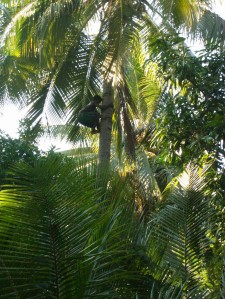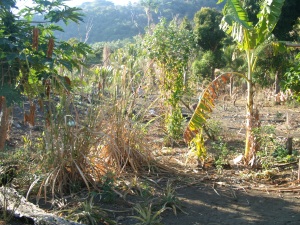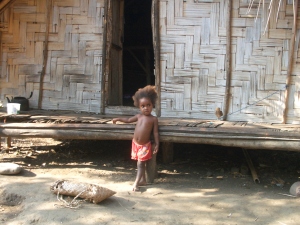


|
Commenced:
|
01/03/2012 |
|---|---|
|
Submitted:
|
25/03/2012 |
|
Last updated:
|
28/10/2020 |
|
Location:
|
93 Golden Gully Road, Kin Kin, QLD, AU |
|
Phone:
|
0754854664 |
|
Website:
|
http://permeco.org |
|
Climate zone:
|
Sub tropical |
(projects i'm involved in)
Project: PermEco Inc.
Posted by Zaia Kendall over 9 years ago
We were invited to come to Vanuatu in August, to go to 2 small
villages and conduct workshops, do a consult on a property and to talk
to government and NGO officials in relation to setting up an ongoing
Permaculture project in Vanuatu. 
Upon arrival our generous sponsor met us at the airport in Luganville, on the island of Espiritu Santo. We drove around Luganville, looking at the markets and had some dinner at a Chinese restaurant. We boarded "Lightship", our sponsor's catamaran, to start our 9 hour journey to Tasmate on the west coast of Santo, at 10pm that night.
We arrived in Tasmate at around 7am the next morning. We were able to sleep in one of the cabins on board for the night. After the supplies were taken to shore in a small motorboat, it was our turn. We landed at a beach with dark course sand and were shown the guest house, a beautiful bamboo hut with a concrete floor, where the local women had made up our beds (mattresses on the floor). It had a little kitchen with a gas stove to boil water. Our food was cooked for us by the locals, who were very hospitable and generous.
We had a short rest and started the workshop that day. Most of the villagers came to have a look and listen. As Tom had already been to Vanuatu to teach a PDC the year before, he had noticed problems on the islands, which were again evident. Topsoil is disappearing at alarming rates, the locals do a lot of burning of organic material. Due to villages moving from forests to beach (on the urging of Westerners), their food sources were sometimes hours away (6 hours away in the second village we visited). Their diet consisted mainly out of root vegetables, some canned meat or fish and white rice, with very little greens. They have a diabetes epidemic, with people in their early twenties dying or getting limbs amputated. Protein sources have diminished, as the ocean is being fished out and they do not kill as many wild fowl as they used to. Their animals roam around freely throughout their villages, thus making it extremely hard for them to have a productive garden close by their house. Tom explained about managing the animals so that they work for you, having gardens close by their houses, so that mineral rich greens are easier grown and used and replenishing topsoil through composting. We found that the local people had all been taught to compost, but they did not understand why they had to. As their population has now increased, burning is no longer a viable method for them as the recovery time for the burnt area is now less and less, so they are losing topsoil. Another problem is that they are putting in plantations of peanuts, cacao, coconuts and cattle, monocropping areas that used to be forested. This now causes issues with nutrients, which are no longer replenished by a diverse forest environment. The topsoil is washed away whenever there is a big rain event (which happens every year in cyclone prone Vanuatu).
Local people also want what Westerners have: their food (eg white rice, white flour, cookies, bread etc), which does not agree with them at all, their buildings (concrete and brick), which does not work at all in their climate as they retain the heat, and other Western material things, which means that people from villages are growing things like peanuts in large quantities (and eat them in large quantities as well, which is causing allergic reactions in most of the local villagers) to sell so they can buy things.

After we were in Tasmate for 2 days, we got up at 3.30am on the second night in Tasmate to take a small motorboat down the coast to another small village called Bareo. This village had only moved down to the beach 5 years ago, because the missionaries built a school and church on the beach. Their gardens were some 6 hours walk away, still in the forest where their village used to be. They are slowly creating more gardens closer by, and people are aware they need to make a change. They recognise that harvests are no longer as abundant as they used to be, so they see there is a problem. We stayed in a lovely bamboo hut with an elevated bamboo floor. We slept on the floor on a bamboo mat, and rigged up our mossie netting. As soft westerners we weren't that comfortable on the floor, but another few days and we would have gotten used to it I reckon! Again the hospitality in Bareo was amazing and the people were very receptive to Tom's advice and observations. They loved making a compost pile, they thought it was very funny to use cow manure (which to village children were told to get, and was brought to us in palm leaves...) The compost pile was covered with Palm leaves to keep the rain off and Tom told them when to turn it, as we were only there for 2 days. On the second night we were there we were invited by the Chief for dinner at his house, where we were given a bamboo mat. Dinner was on the ground on bamboo mats, with some lighting from the fire in the hut and solar torches. That night we got up at 3.30am again for our trip back.

We arrived back at Tasmate at around 8am, and were taken up to our sponsor's property, where Tom consulted them on future developments and gardens. We left late afternoon, to take the catamaran back to Luganville later that night. We spent the day and night in Luganville at a lovely B&B, organised by our sponsor. The next day we flew to Port Villa for our discussions with government and NGOs.
Everyone was very receptive in Port Villa and understood what Tom was talking about in relation to fertility loss. They are aware there is a soil loss problem and that the health of the population is severely declining. We pointed out the lack of diversity in the diet, and that diversity in the gardens will lead to diversity of food consumed. To help educate local Ni-Vanuatu people, we have suggested we start a PRI in Luganville, followed by one in Port Villa. They will be Permaculture Demonstration sites where we will run PDCs and longer term practical experiences for local people. The sites will be set up with buildings that are traditional to the villages (bamboo walls, thatch roofs, elevated bamboo and/or dirt floors). This is to show the local people that their style of building works for their environment, they are sustainable and easily rebuilt, should a cyclone destroy them. This will also show people that Western style buildings (with their imported concrete and bricks) are not something they need to strive for. We aim to show them that they have such wonderful traditions and such an abundant natural environment, that they will be able to support that abundance by learning how to work with nature in the Permaculture way. We are currently negotiating with government and NGOs in order to set these sites up, we are hoping that we can run our first PDC there by the end of 2015.

©2014 Permaculture Research Institute Sunshine Coast - Permaculture in Vanuatu, Permaculture Research Institute Master Plan sites in Vanuatu
You must be logged in to comment.


Note: The various badges displayed in people profiles are largely honesty-based self-proclamations by the individuals themselves. There are reporting functions users can use if they know of blatant misrepresentation (for both people and projects). Legitimacy, competency and reputation for all people and projects can be evidenced and/or developed through their providing regular updates on permaculture work they’re involved in, before/after photographs, etc. A spirit of objective nurturing of both people and projects through knowledge/encouragement/inspiration/resource sharing is the aim of the Worldwide Permaculture Network.
 |
MemberA member is a permaculturist who has never taken a PDC course. These cannot become PDC teachers. Members may be novice or highly experienced permaculturists or anywhere in between. Watch their updates for evaluation. |
|---|---|
  |
Permaculture MatchmakerOne of these badges will show if you select your gender and the "I'm single, looking for a permaculture partner" option in your profile. |
 |
PDCPeople who claim to have taken a Permaculture Design Certificate (PDC) course somewhere in the world. |
 |
PDC VerifiedPeople who have entered an email address for the teacher of their PDC course, and have had their PDC status verified by that teacher. Watch their updates for evaluation. |
 |
PRI PDCPeople who’ve taken a Permaculture Research Institute PDC somewhere in the world. |
 |
PDC TeacherPeople who claim to teach some version of PDC somewhere in the world. |
 |
PRI TeacherWith the exception of the ‘Member’ who has never taken a PDC, all of the above can apply to become a PRI PDC Teacher. PRI PDC Teachers are those who the PRI recognise, through a vetting board, as determined and competent to teach the full 72-hour course as developed by Permaculture founder Bill Mollison – covering all the topics of The Designers’ Manual as well as possible (i.e. not cherry picking only aspects the teacher feels most interested or competent in). Such teachers also commit to focussing on the design science, and not including subjective spiritual/metaphysical elements. The reason these items are not included in the PDC curriculum is because they are “belief” based. Permaculture Design education concerns itself with teaching good design based on strategies and techniques which are scientifically provable. PRI PDC Teachers may be given teaching and/or consultancy offerings as they become available as the network grows. |
 |
Aid WorkerThe individual with this badge is indicating they are, have, or would like to be involved in permaculture aid work. As such, the individual may or may not have permaculture aid worker experience. Watch their updates for evaluation. |
 |
ConsultantThe individual with this badge is indicating they are, have, or would like to do paid permaculture design consultancy work. As such, the individual may or may not have permaculture consultancy experience. Watch their updates for evaluation. |
 |
Community ProjectCommunity projects are projects that help develop sustainable community interaction and increase localised resiliency. |